Have you ever followed a dream?
I always wanted to see the Pyramids of Egypt. So whilst on exchange in Europe, I concluded that you only live once, and there are only so many chances you get to jump. I daydreamed too much, agonised about my decision…and then I decided to go see the Pyramids.
Here’s a one-week itinerary of my sojourn in Egypt: a whirlwind adventure on a tight schedule and an even tighter budget.
The Adventure in Brief
If you go and look up Egypt on a map of the world, it looks a little like the quadrant of a circle. From the tip of that quadrant in Cairo, I leapfrogged all the way to the south (a night flight via Egyptair), before making my way slowly back north to Cairo by train and bus, stopping at the cities of Aswan and Luxor along the way, in a one-week circuit. Here’s how you can do it in 4 phases.
Phase 1 Cairo
1.5 days here, settling in and seeing the Pyramids at Giza
Phase 2 Aswan
2 days: visiting the ancient, restored temple at Abu Simbel (near the Egypt-Sudan border), and exploring the city’s islands, ancient tombs, monasteries and museums.
Phase 3 Luxor
2 very rich and full days, visiting fabled ancient temples and tombs. Perhaps one of the cheapest place in the world to ride in a hot-air balloon, too.
Phase 4 Cairo
1.5 days here, at the end of my loop. This last day was spent exploring the city itself. The Egyptian Museum, and the Coptic Christian quarters of this bustling city, are places worth exploring on a tight schedule and budget.
That was just a brief summary. Read on for the fuller adventure…
Phase 1: Cairo/Giza
I landed at Cairo International Airport on a cloudless afternoon in mid-May.
Visas are available on arrival (50 USD) at bank counters in the airport, before immigration. Change Egyptian pounds (LE) here if you like, but take care to count your money carefully before you leave! The relative calm of the airport is a good place to familiarise yourself with the various colours and patterns of Egyptian currency before the searing heat, noise and chaos of Cairo assail you.
How to get from the airport to the city is an interesting question with two answers, either by taxi or by public transport. The question can also be rephrased as: how crazy adventurous are you?
Taxi
As a veteran of the second option (public transport), my advice is: take a taxi. It’s definitely going to cost you more, but doing so will save you a lot of time, headaches and confusion. It is in all likelihood a safer option as well. An average taxi trip from Cairo Airport to downtown Cairo should not cost more than 50-60 LE, whilst a journey from Cairo Airport to the Pyramids go for 100-110 LE.
Public Transport
If, however, you want to go the longer way, and see more in the process – then prepare some patience, time, and small change in advance. Be ready to ask around for directions too, as English signage is still relatively scarce.
1. A free shuttle bus runs in 30 minute intervals between Cairo Airport’s two airport terminals and the local bus station, 24 hours a day. Ask for the location of the shuttle service at information counters inside the terminal first.
2. Once at the airport bus station, you can take buses 111, 356 or 27 to downtown Cairo, the transport node to other destinations around Cairo. At the bus station, ask around to check for the departure timings of the buses. Come prepared also to recognise Arabic numerals, which are different from the internationally recognised Hindu-Arabic notation.
So: ask around. And if nobody speaks English:
- Universal frantic ‘sign language’ helps, as I found out: show triangles with your hands.
- Carry a picture of the pyramids with you.
- Finally, ask around for “al-ahram”, which is Arabic for Pyramids.
- Use a combination of all the above. The landmark is such a well-known tourist attraction that someone at the bus station is bound to recognise your query quickly enough.
3. The bus from Cairo Airport to Tahrir Square in downtown Cairo cost me 2 LE and took me about an hour.
4. From downtown Cairo, at the Abdel Menem Riyad Station in Midan Tahrir, next to the Egyptian Museum, buses 355 or 357 can take you to Giza and the Pyramids. Tickets similarly cost 2 LE.
This wasn’t what happened to me, however. Reaching the city from the airport was only the first part of my adventure. Snarled up in a traffic jam near Tahrir Square in downtown Cairo, my bus driver motioned excitedly for me to board another bus several metres away, yelling “al-Ahram, al-Ahram!” at me. I literally ran from one moving bus to another, cheered on by fellow passengers – and hoped for the best.
This bus turned out to be the right one, and I shuffled my way sheepishly to the back of the crowded bus with my gigantic backpack, watched on by puzzled, bemused locals. But this short time crammed cheek-by-jowl with Egyptians gave me a sense of what its people were like.
45 minutes on the bus showed me a sincere and honest people who touched me in the little things they did. A man at the back of the crowded bus beckoned me over to a newly freed-up seat. Watching the entire bus of passengers pass my bus fare from person to person to the conductor at the front of the bus; then watching in amazement as they passed my bus ticket (plus my change) back to me, from the conductor. I marvelled at the quiet, gentle humanity amidst the hot, claustrophobic confines of a noisy, old bus.
The Public Transport Option to Giza in 4 Stages:
Cairo Airport →[SHUTTLE BUS]→ Airport Bus Station →[PUBLIC BUS]→ Downtown Cairo → [PUBLIC BUS] → GIZA
Arriving at Giza
Once the bus drops you off, however, steel yourself. The Pyramids are a world-class tourist destination, known the world over. This also means that everyone in Giza who wants to rip the unprepared tourist off is probably here too.
It’s best if you already have directions to your accommodation once you get off the bus. Keep your eyes open, and walk like you know where you’re going (even if you don’t).
Ignore the touts. Ignore all of them. Ignore anyone who wants to start a conversation, but then starts offering you camel rides. The camel ride is free if you want to get onto the camel, yes. As I learned, getting off the back of such a tall and unpredictable creature could be an expensive experience.
Unsavoury touts ready to make you tip for every and any act of “Egyptian hospitality” cluster in dense clots around the entrance to the pyramids – so if you’re travelling alone (like I was), it’s best to keep conversations with strangers here minimal unless absolutely necessary. Sure, it’s good to keep an open heart and open mind when travelling – but here, it’s best to exercise more prudence and wariness to any stranger who’s suddenly friendly to you, or strikes up a conversation in English.
“You should just walk away,” my Airbnb host, Thomas, who runs the Pyramids Loft homestay, advised me when I finally recounted my tale to him. Thomas’ place was amazing: it had a rooftop view of the Pyramids, so you more or less had a front-row view of those great wonders of the world as the sun sets; and then the next morning too, as the dawn slowly cast its apricot glow on those massive, superlative monuments.
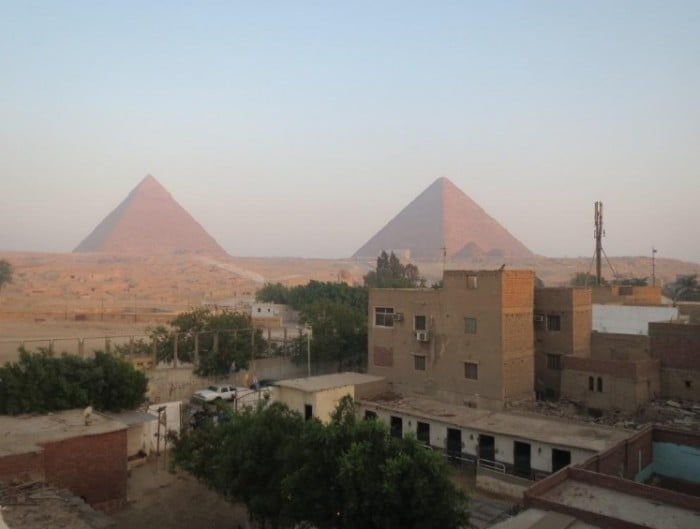 Above: The Pyramids at dawn (writer’s own photo)
Above: The Pyramids at dawn (writer’s own photo)
The Pyramids at Giza
Day Two of my all-too short stay in Giza had Thomas bringing me around the Pyramids, the entrance which was more or less outside the accommodation. It was like going to your neighbourhood hawker centre for breakfast – except that the attraction was 4000 years old.
These breathtaking monuments were already ancient when the Chinese were building their Great Wall; the material testament to an age and a people as old as myth.
It was surreal to stand in the dry Egyptian heat, gazing up into the inscrutable face of the Sphinx, or beholding monuments which took about two million stone blocks to build. These weren’t just pyramids, these were the Pyramids.
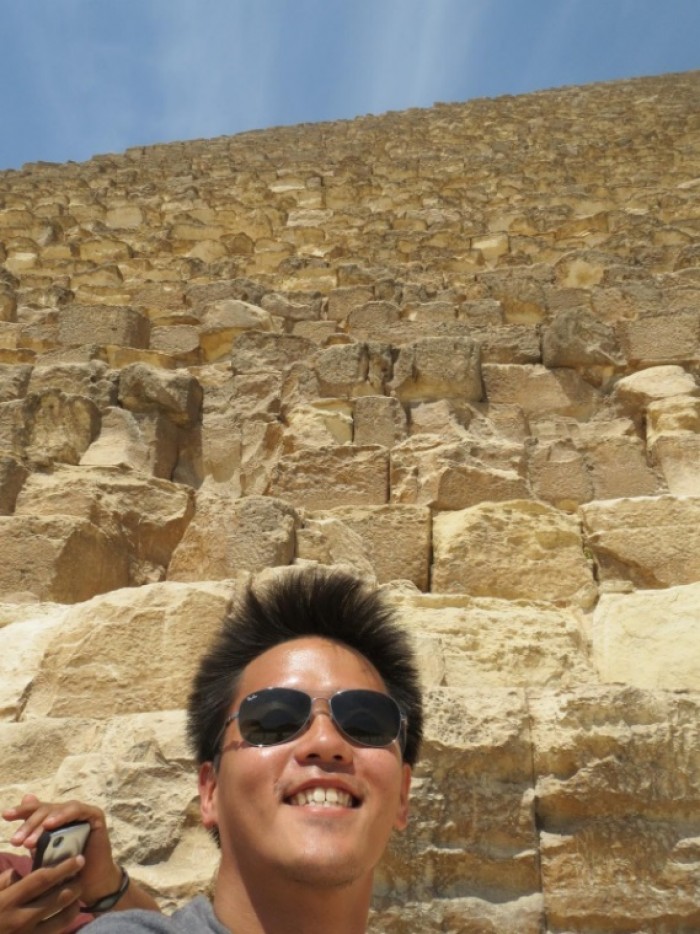
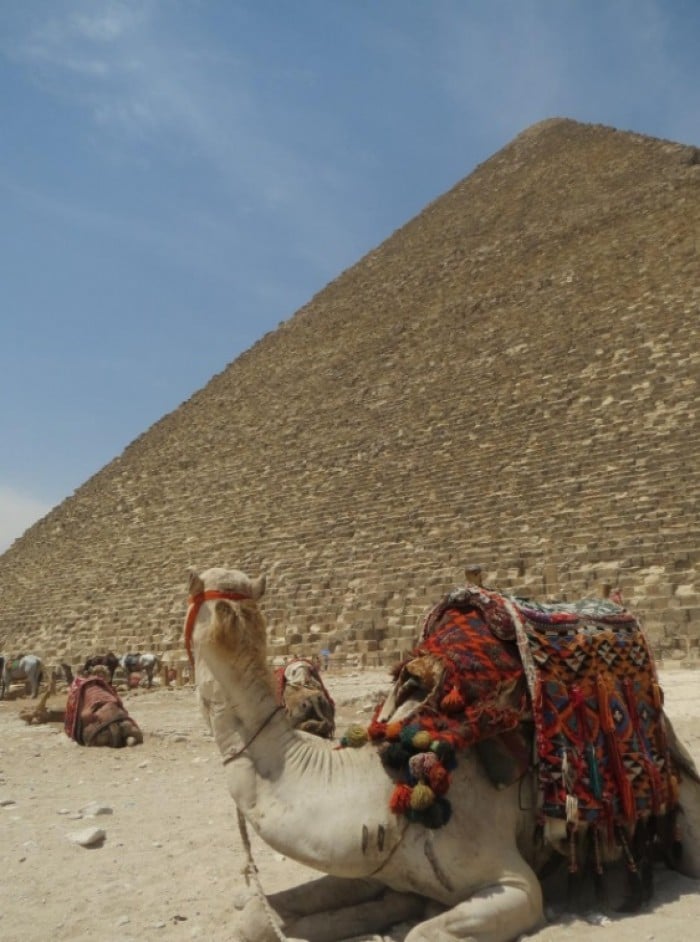
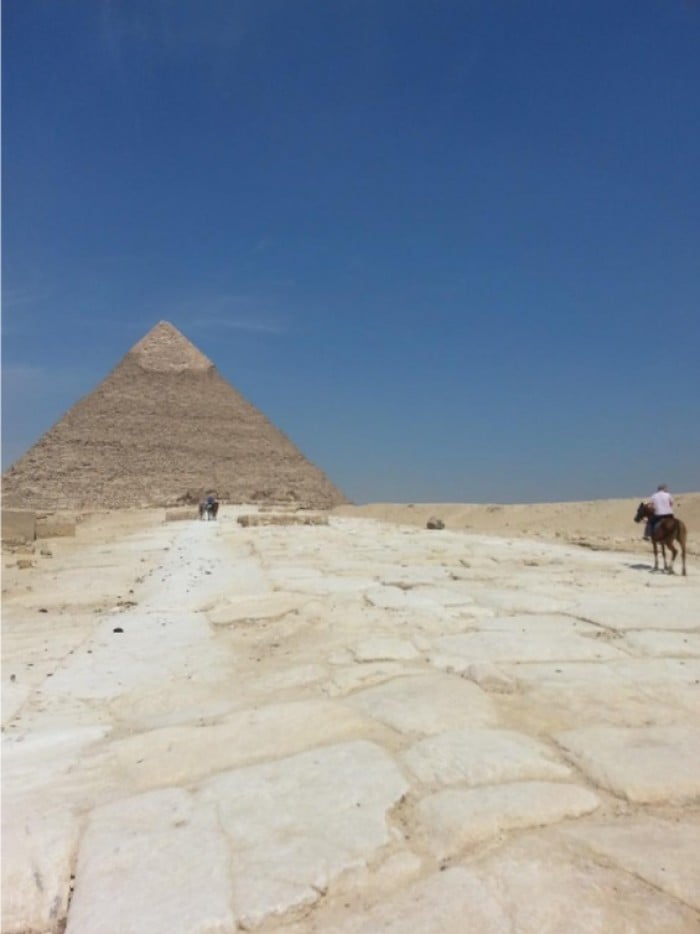
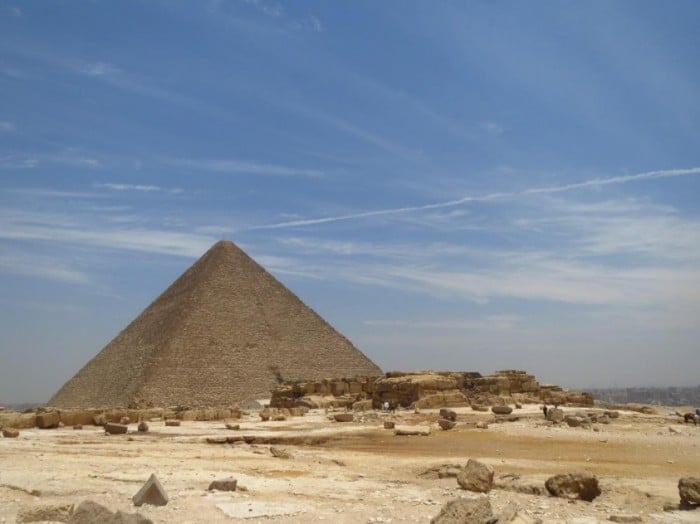
In the evening, with a night flight to catch, I made my way to the airport using a combination of minibus, subway train and taxi. My night flight from Cairo to Aswan, a journey of about 700km, took only 1 hour 20 minutes by aeroplane. It would have taken nearly 10 hours to do the same journey overland.
 Above: Boarding the night flight to Aswan from Cairo. (Writer’s own picture)
Above: Boarding the night flight to Aswan from Cairo. (Writer’s own picture)
Phase 2: Aswan
I landed in Aswan half an hour after midnight, borne on an airline (Egyptair) whose logo resembled Horus, the Egyptian falcon god of the sky. At the airport, I took a taxi to Aswan city, since public buses don’t go to the airport. The taxi cost me 40 LE.
The streets of Aswan are serene and silent at midnight, and the warm air streaming in through the car window smelled of promise and possibility. My driver dropped me off at my hostel, which was located a short walk from the Aswan train station.
Abu Simbel
After my arrival, I settled in to sleep the remaining few hours before a shuttle came to pick me up at 4am to bring me to the rock temples at Abu Simbel. These temples had been built about 3000 years ago in the reign of Ramesses II, to commemorate his victory at the battle of Qadesh against the Nubians. Sacrifice some sleep here – the grand temples of Abu Simbel are absolutely worth the early morning.
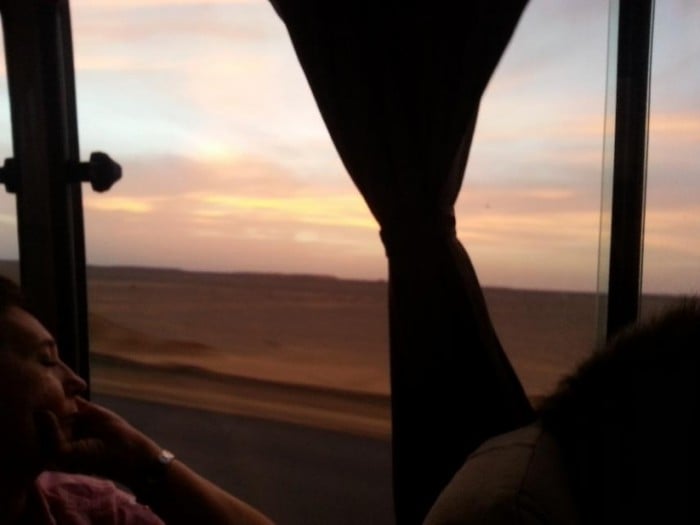 Above: Sunrise en route to Abu Simbel
Above: Sunrise en route to Abu Simbel
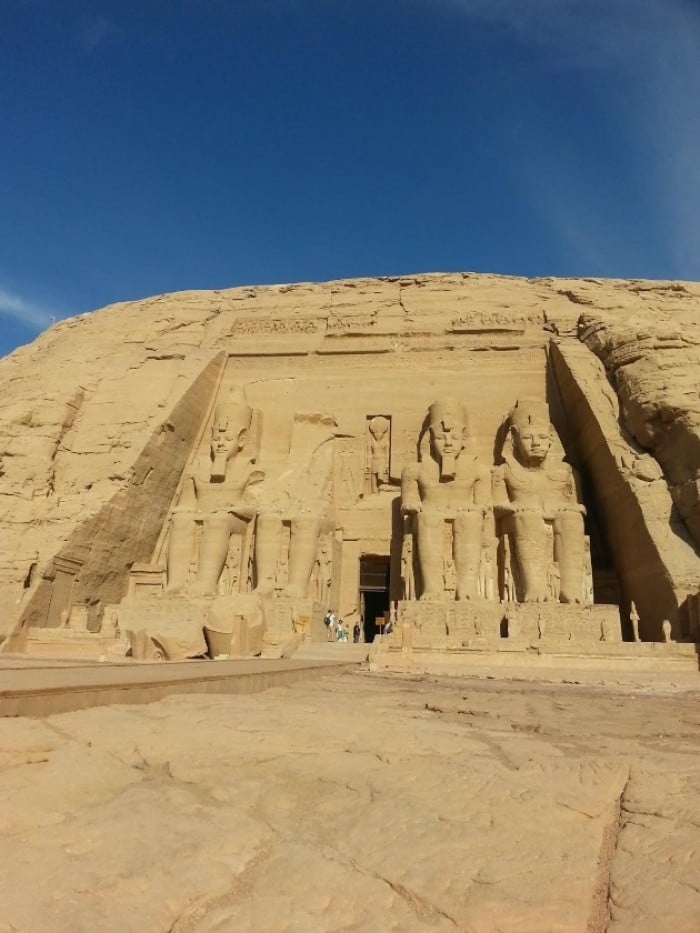 The Great Temple of Ramses II (writer’s pictures)
The Great Temple of Ramses II (writer’s pictures)
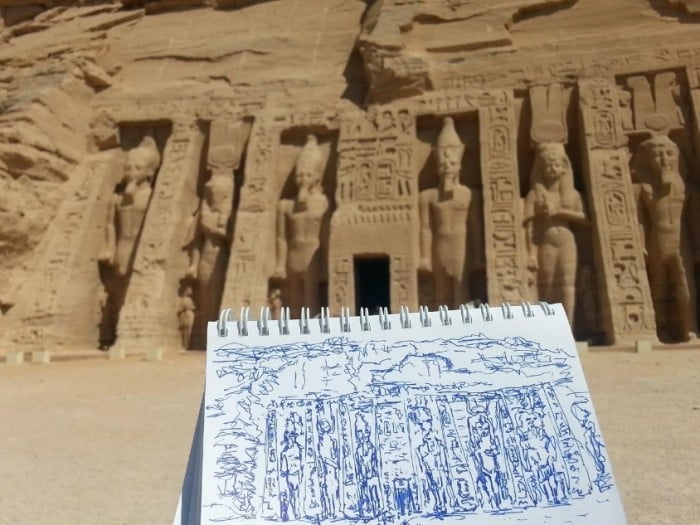 Above: Sketch of the Temple of Hathor, done by the writer
Above: Sketch of the Temple of Hathor, done by the writer
Within Aswan
On a tight budget, I spent my next 2 days within the environs of Aswan. Aside from the fascinating town and marketplaces, in the city, you can cross the river to explore Egyptian tombs on Aswan’s West Bank.
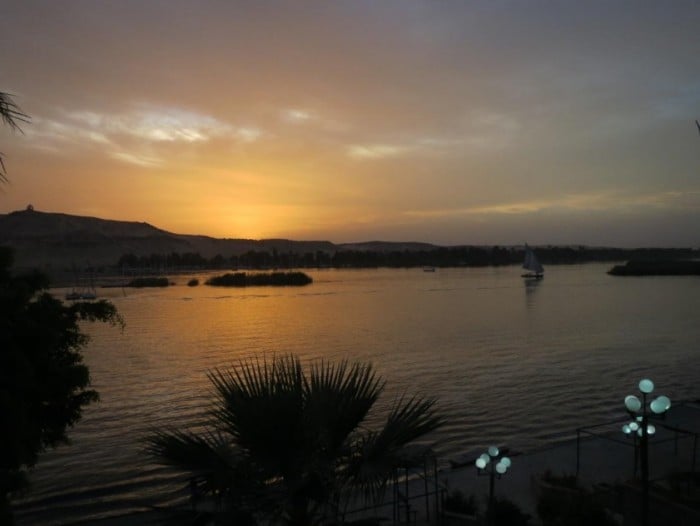 Sunset on the Nile.
Sunset on the Nile.
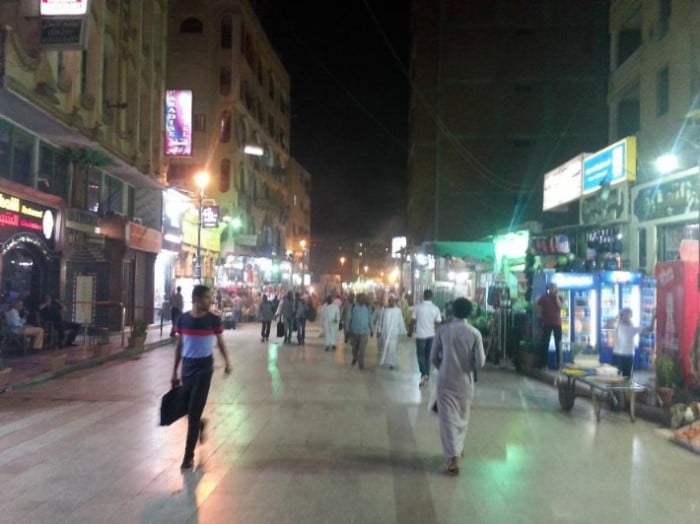 Aswan city in the evening
Aswan city in the evening
Sights on the opposite bank of the city include the tombs of Egyptian nobles, and the Kubbet el-Hawa or “Dome of the Wind”, a small shrine which will offer you stunning views of Aswan.
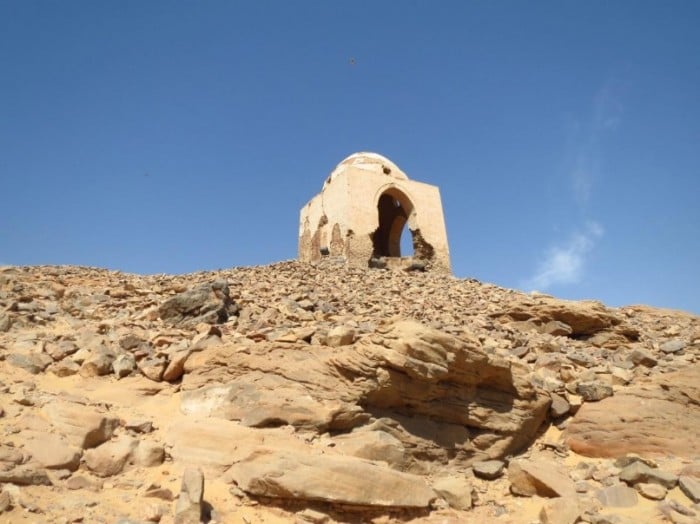 Above: The Kubbet el-Hawa on the West Bank of Aswan
Above: The Kubbet el-Hawa on the West Bank of Aswan
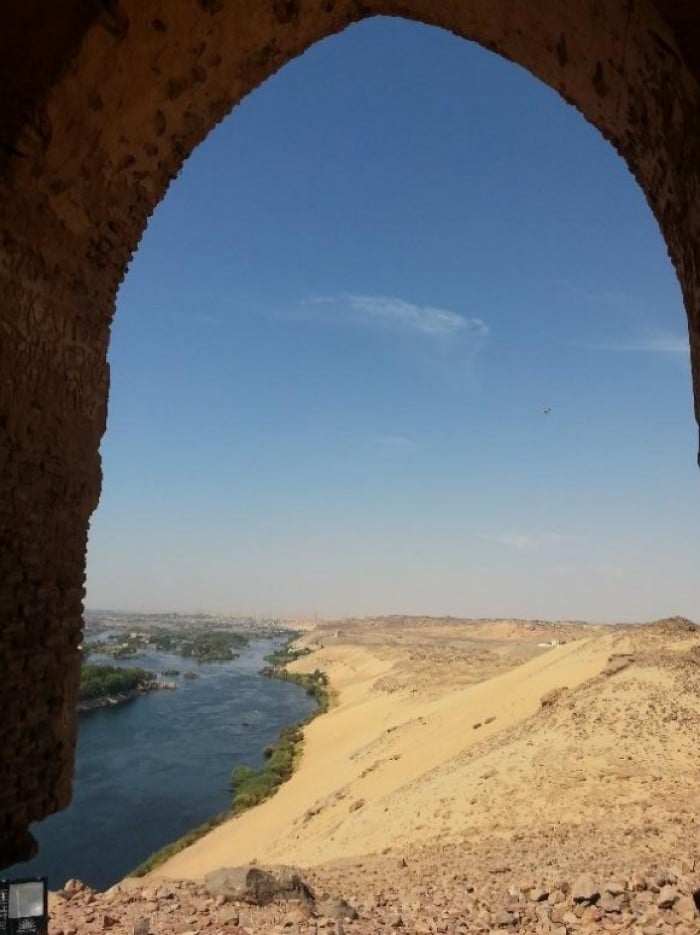 View of Aswan from the Kubbet el-Hawa
View of Aswan from the Kubbet el-Hawa
From here, trek over to the St Simeon Monastery (make sure you have enough water!), whose history dates back to the 7th century AD.
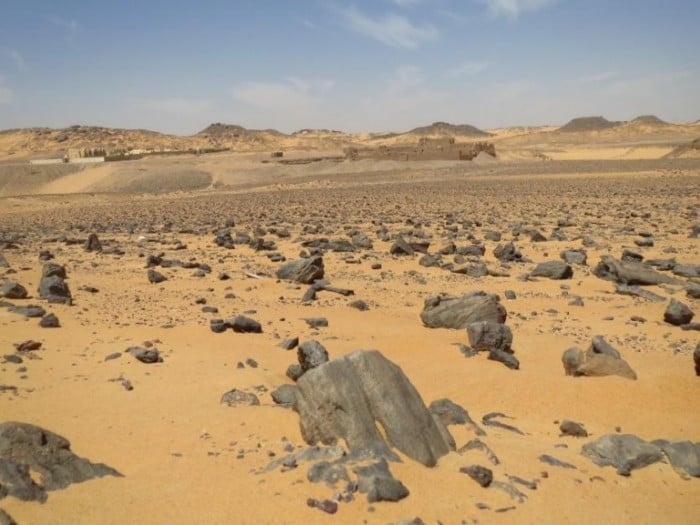 The St Simeon Monastery in the distance, trekking from the Kubbet el-Hawa
The St Simeon Monastery in the distance, trekking from the Kubbet el-Hawa
There is also the richly stocked and highly informative Nubian Museum, which offers illuminating insights into the civilisations that once existed in this region.
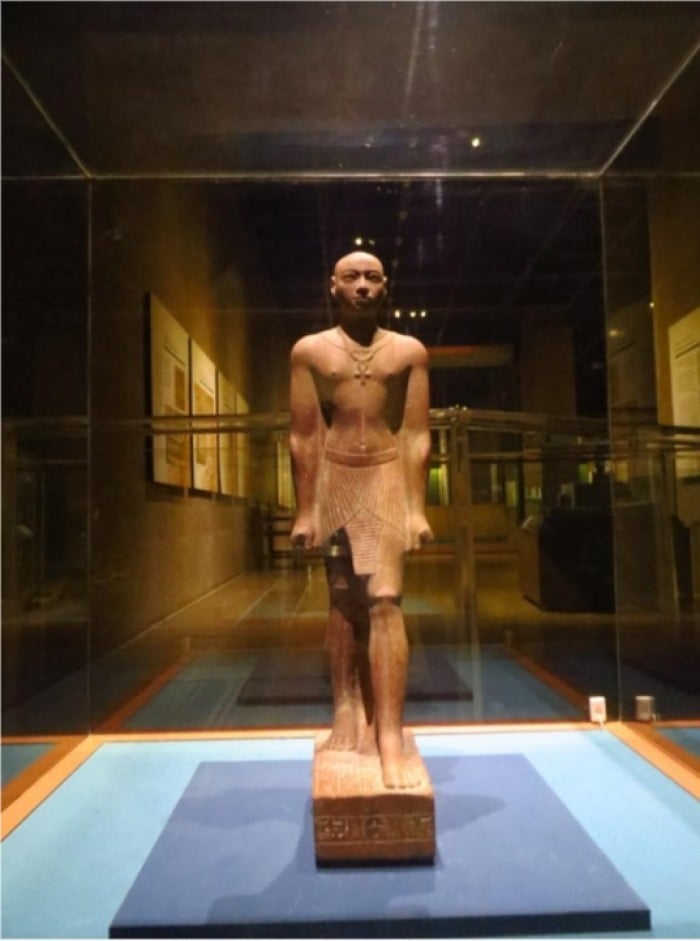 Displays at the Nubian Museum
Displays at the Nubian Museum
Phase 3: Luxor
Getting to Luxor
After 2 days in Aswan, I caught the 5.30am train from Aswan to Luxor, a journey that took me slightly more than three hours. The cabin I was on was air-conditioned, and I dozed comfortably in it, as the Egyptian landscape whipped past.
Last look: Preparing to depart Aswan at 5.30am
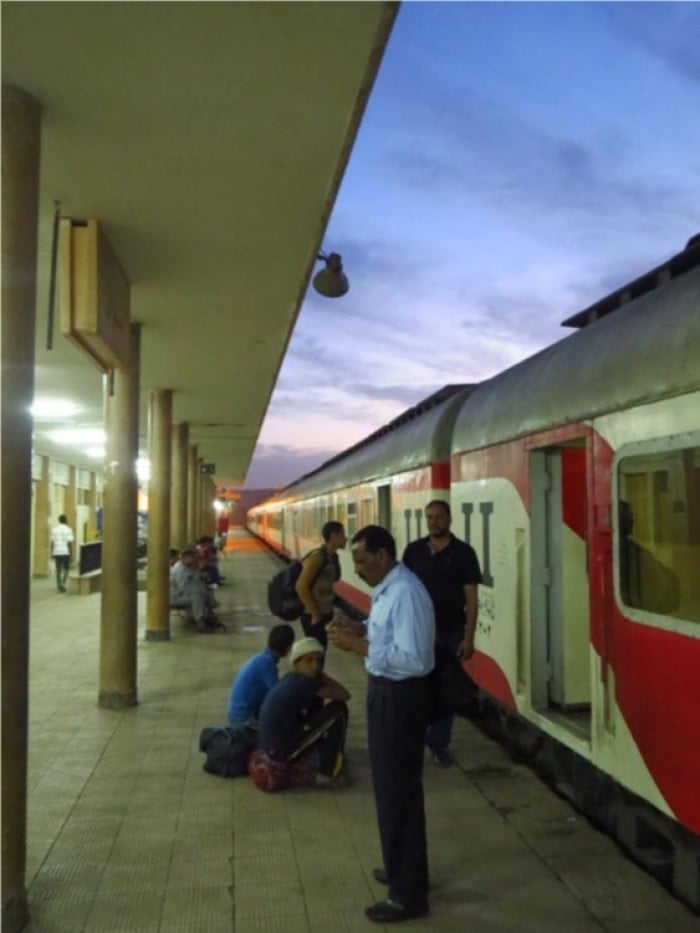
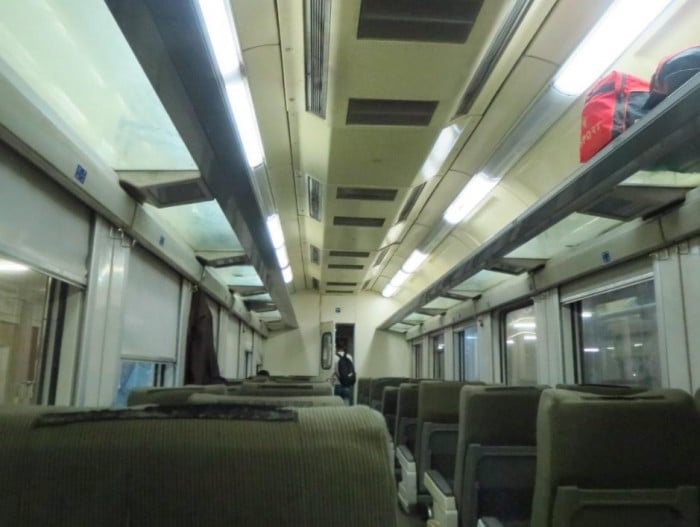 Air-conditioned cabin. The three-hour train journey to Luxor cost 25 LE
Air-conditioned cabin. The three-hour train journey to Luxor cost 25 LE
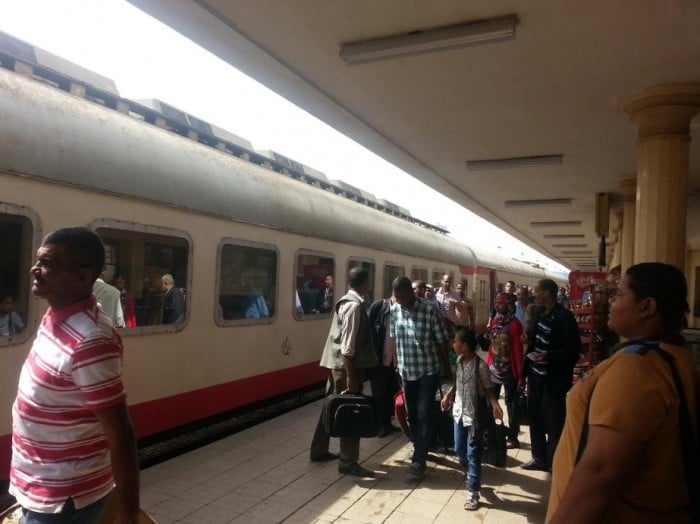 Hustle and bustle: Arrival at Luxor Railway Station
Hustle and bustle: Arrival at Luxor Railway Station
Luxor was personally my favourite of the three Egyptian cities I had the chance to visit. I found it an even balance between the chaos of a big city like Cairo, and the quaint, grubby charm of a smaller town like Aswan.
Valley of the Kings and the West Bank
I went for a guided tour around the Valley of the Kings and the West Bank, where great monuments to forgotten kings still stretched into the lone and level sands. After the astronomical wealth of the Pyramids was plundered, later Pharaohs had decided to hide their treasures and mausoleums deep in the desert, now re-discovered here in the so-called Valley of the Kings.
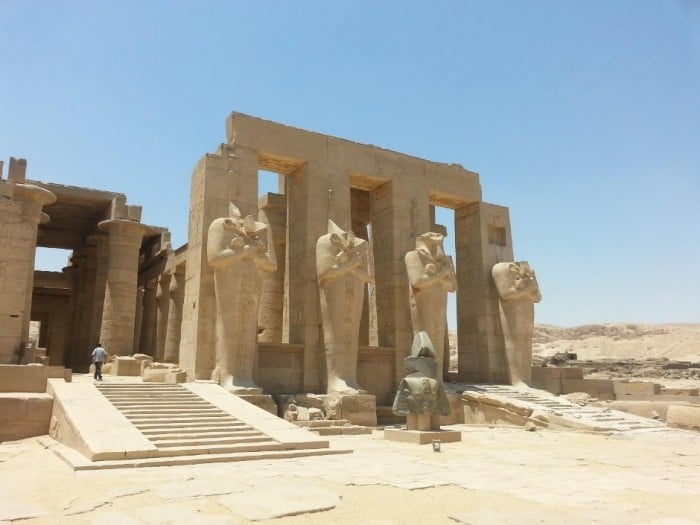
Peter, my guide, drove me around in a tiny Russian-made car which was close to twenty years old. “They don’t make them like that anymore,” he lamented to me, in between our visits to ancient temples. I absently wondered if he was referring to his car or those soaring columns the Egyptians had raised so many millennia ago.
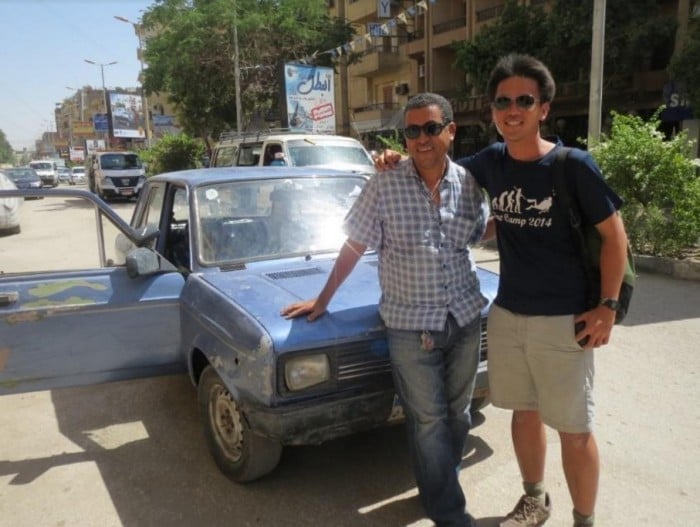 Above: Peter, his beat-up car, and me
Above: Peter, his beat-up car, and me
The Marvels in Luxor
The city of Luxor itself offers plenty of sights too. You can catch an early-morning hot air balloon ride here if the weather permits.
If altitudes aren’t for you, the beautiful Temples of Luxor and Karnak await. I bumped into an Egyptologist whilst wandering the Temple of Luxor, and spent a mind-blowing and breathtaking afternoon walking these temples, having the rich, poetic symbolism of Egyptian hieroglyphics and architecture explained to me.
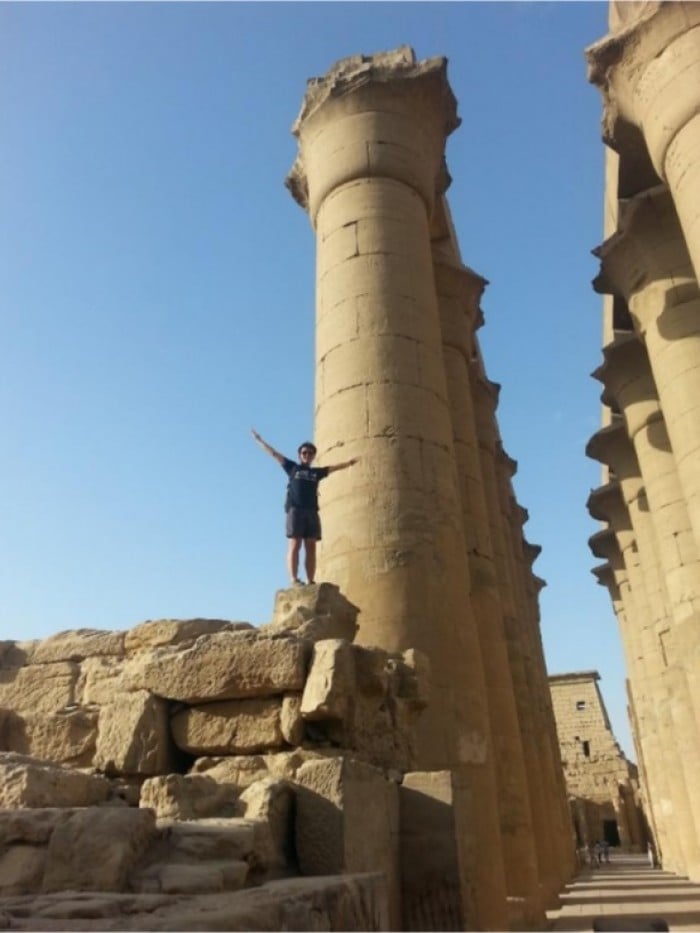 At the Temple of Luxor, you clearly see that the Egyptians had an ambitious sense of scale
At the Temple of Luxor, you clearly see that the Egyptians had an ambitious sense of scale
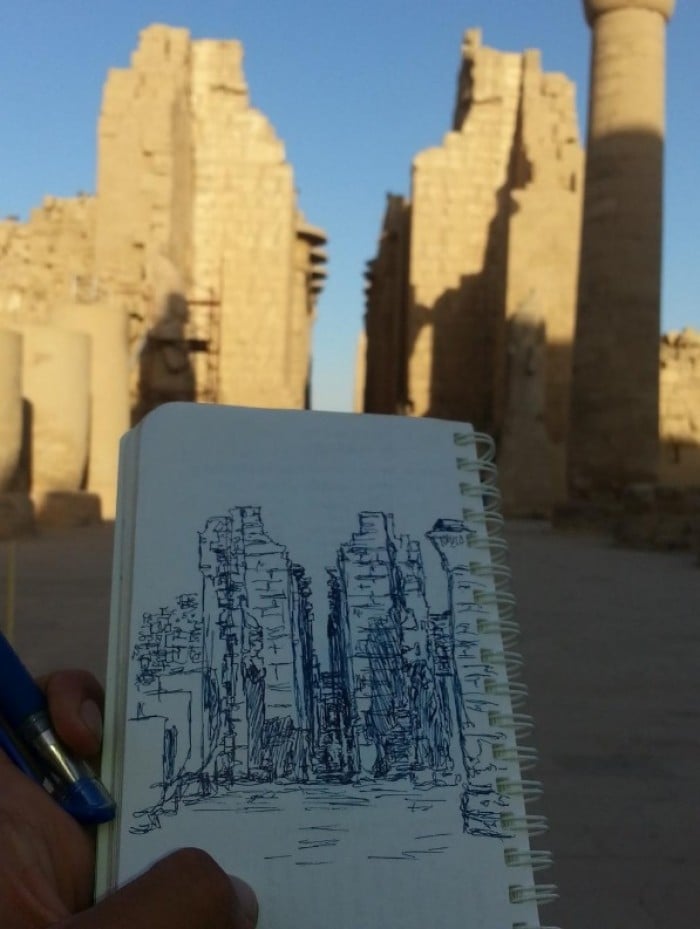 Sketch at the Temple of Karnak
Sketch at the Temple of Karnak
Luxor was a quiet city when I visited it in May 2015, but its people were in quite a bad shape, I think. The tourist industry was virtually at a standstill, and every other horse-carriage driver (plenty in this city, very affordable) whom I sat with had a story of hardship to tell me. It’s unnerving to be pressed for baksheesh (tips) so persistently and so desperately.
It’d be so easy from such instances to accuse Egyptians of being greedy, dishonest and desperate. But I think a grown man with four children does not want to wheedle you for more money unless he really has no choice. Egypt’s tourist sector has been hit rather bad in recent years by the threat of terrorism.
Getting Out
After the sights and stories of Luxor, I secured an overnight bus that would take me all the way to Cairo. For 110 LE, you get a seat on an air-conditioned, 9-hour bus journey, a box of savoury snacks, and two bottles of water.
It was as comfortable and uneventful as any long-distance bus ride I’d been on in Southeast Asia. The passenger composition was overwhelmingly local, though; save a few Australian backpackers, the bus was filled with businessmen, labourers and students heading north to their capital city.
Phase 4: Cairo
Returning to Cairo
There’s something to be said about travelling overnight. Not only is it often more affordable, you save on lodging – and must wonderfully disorienting of all – you get to wake up in a completely different place, hundreds of kilometres from where and when you had last closed your eyes.
My overnight bus dropped me in the heart of Cairo, near Tahrir Square, at about 5am in the morning, 9 hours and some 650km from where I had boarded it. For such a gloriously messy city, Cairo was astonishingly subdued at this hour of the morning. It’s said that you see a city’s ghosts best when you walk its streets at dawn. With the dawn chill still hanging in the lightening sky, Cairo was no different. I walked to my hostel accompanied only by a peaceable silence, gilded by the rays of a rising sun.
In Cairo
Let the artefacts of bygone civilisations dazzle you at the Egyptian Museum. This is the place you must go if you are in Cairo, and want to learn about the Egyptian dynasties. There’s probably no other place in the world so (legally and rightfully) crammed with so many ancient historical artefacts. Tutankhamun’s fabled treasures alone are worth the visit, to say nothing of the lovingly carved sarcophagi, the intricately painted papyrus scrolls, and the impressively preserved mummies. I’ve never seen so much gold in one place before, let alone such intricate metalwork.
Aside from the Museum, Cairo has plenty else to offer; you could probably spend weeks here and still find something new to marvel at. Check out the Citadel and Mosque of Mohammed Ali Pasha in Islamic Cairo, a grand fortress built by the legendary Muslim general, Saladin. Or behold the al-Azhar Mosque, home to the world’s oldest university, and a deeply influential institution of the modern Islamic world.
I spent an afternoon in the Coptic Christian quarter, home to one of the country’s oldest Christian denominations. The small, quiet churches in this part of the city exude a quaint, honest charm, surrounded by a community going about their daily life. Curious little kids stopped their football matches to stare openly at this Chinese backpacker. The braver ones came up shyly to shake my hand; one even took a photo with me.
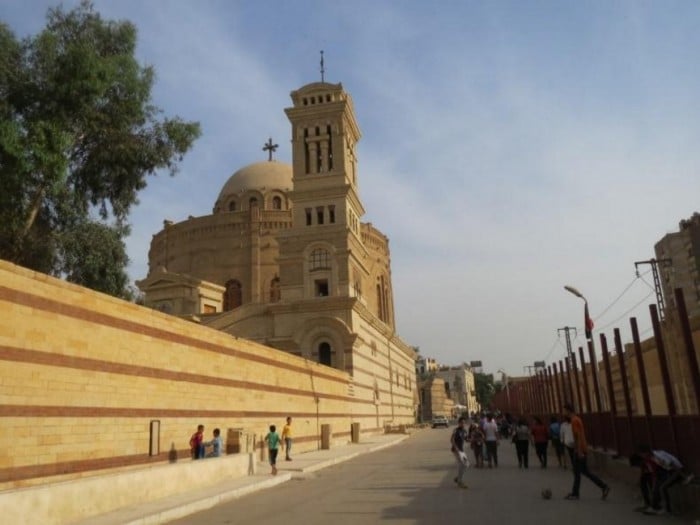 Children at play at Cairo’s Coptic Christian quarters
Children at play at Cairo’s Coptic Christian quarters
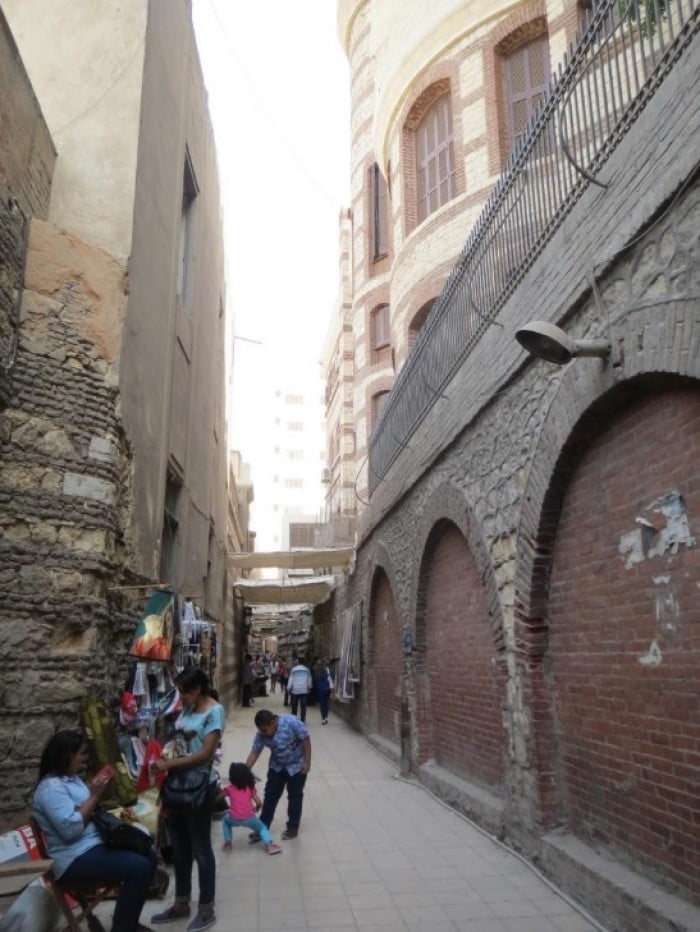 The narrow alleys in the Quarter
The narrow alleys in the Quarter
Also read: “Exotic Travel” Does Not Mean “Dangerous Travel”
Conclusion
Preparing a trip to Egypt will inundate you with travel advisories telling you to exercise caution, because the threat of terror remains high in this country. Egypt remains a politically unstable country. This is the unfortunate reality of the world we live in today. But let that not blind us to the sheer beauty the world still has to offer; the inherent exhilaration of travel and discovery. Adventure is necessarily tinged with some discomfort and uncertainty. In exchange one is often privileged with new perspectives and vast horizons; glimpses into unimaginably old civilisations.
“It’s the possibility of having a dream come true that makes life interesting.”, Coelho remarked in his book The Alchemist. Likewise, if you have ever dreamed of seeing the Pyramids, or to smell the hot sands of Egypt.




